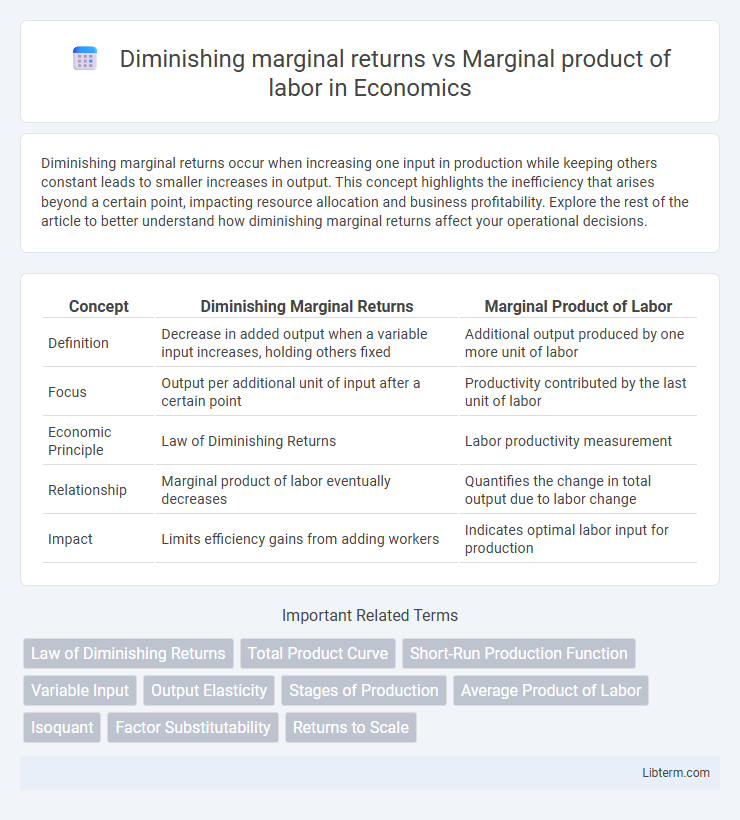Diminishing marginal returns occur when increasing one input in production while keeping others constant leads to smaller increases in output. This concept highlights the inefficiency that arises beyond a certain point, impacting resource allocation and business profitability. Explore the rest of the article to better understand how diminishing marginal returns affect your operational decisions.
Table of Comparison
| Concept | Diminishing Marginal Returns | Marginal Product of Labor |
|---|---|---|
| Definition | Decrease in added output when a variable input increases, holding others fixed | Additional output produced by one more unit of labor |
| Focus | Output per additional unit of input after a certain point | Productivity contributed by the last unit of labor |
| Economic Principle | Law of Diminishing Returns | Labor productivity measurement |
| Relationship | Marginal product of labor eventually decreases | Quantifies the change in total output due to labor change |
| Impact | Limits efficiency gains from adding workers | Indicates optimal labor input for production |
Introduction to Marginal Product of Labor
The marginal product of labor (MPL) measures the additional output generated by employing one more unit of labor while keeping other inputs constant. Diminishing marginal returns occur when the MPL begins to decrease as more labor is added, indicating less efficient resource utilization. Understanding MPL is crucial for analyzing labor productivity and optimizing workforce allocation in production processes.
Defining Diminishing Marginal Returns
Diminishing marginal returns describe the stage in production where adding an additional unit of labor leads to a smaller increase in output compared to previous units. This concept contrasts with the marginal product of labor, which measures the change in total output resulting from a one-unit increase in labor input. Understanding diminishing marginal returns is crucial for optimizing resource allocation and maximizing production efficiency in economic modeling.
Key Differences Between Concepts
Diminishing marginal returns refer to the decrease in the additional output produced when one variable input, typically labor, is increased while other inputs remain constant, highlighting a declining efficiency in production. The marginal product of labor measures the additional output generated by one more unit of labor, serving as a quantifiable metric for labor productivity. Key differences lie in the scope: diminishing marginal returns describe the trend of decreasing gains, whereas the marginal product of labor provides the specific incremental output value at each labor input level.
The Law of Diminishing Marginal Returns Explained
The Law of Diminishing Marginal Returns explains that as more units of labor are added to a fixed amount of capital, the additional output produced by each new worker eventually decreases. This principle highlights that while the Marginal Product of Labor (MPL) initially rises with added labor, it reaches a peak and then declines due to limited resources and overcrowding. Understanding this relationship is crucial for optimizing labor input and maximizing production efficiency in economic and business contexts.
Marginal Product of Labor: Calculation and Importance
Marginal Product of Labor (MPL) measures the additional output generated by employing one more unit of labor, calculated as the change in total output divided by the change in labor input. This metric is crucial for firms to determine the efficiency and productivity of their workforce, guiding optimal hiring decisions and resource allocation. Understanding MPL helps businesses maximize profit by balancing labor input against diminishing marginal returns, where adding more labor eventually leads to smaller increases in output.
Factors Influencing Marginal Returns
Factors influencing marginal returns include changes in labor efficiency, technology, and capital availability, which directly impact the marginal product of labor by altering output per additional worker. Diminishing marginal returns occur when adding more labor leads to smaller increases in output due to fixed inputs and resource constraints. Understanding these factors helps optimize workforce size and resource allocation to maximize productivity.
Real-World Examples in Production
The concept of diminishing marginal returns is evident in agriculture, where adding more workers to a fixed amount of land eventually leads to less additional output per worker, illustrating how marginal product of labor decreases after a certain point. In manufacturing, the marginal product of labor rises initially as workers specialize but declines when overcrowding or limited machinery restricts productivity. Real-world firms must balance labor input to avoid inefficiencies caused by diminishing marginal returns while maximizing the marginal product of labor for optimal production.
Impacts on Business Decision-Making
Diminishing marginal returns occur when adding additional units of labor results in progressively smaller increases in output, directly influencing resource allocation strategies in business operations. The marginal product of labor measures the incremental output generated by an additional worker, serving as a critical metric for optimizing workforce size and productivity. Understanding the interplay between diminishing marginal returns and marginal product of labor enables businesses to make informed decisions on labor investment, cost management, and maximizing overall efficiency.
Addressing Common Misconceptions
Diminishing marginal returns refer to the decrease in the additional output gained from one more unit of input, usually labor, when other inputs remain fixed, while marginal product of labor measures the actual additional output produced by an incremental unit of labor. A common misconception is that diminishing marginal returns imply negative productivity, but in reality, it means that each additional worker contributes less than the previous one without necessarily reducing total output. Understanding the distinction clarifies that marginal product of labor can remain positive even as diminishing marginal returns set in.
Conclusion: Integrating Both Concepts in Economics
Diminishing marginal returns highlight the decreasing incremental output as more units of a single input, such as labor, are added while keeping other inputs constant. The marginal product of labor specifically measures the additional output generated by employing one more worker. Integrating both concepts allows economists to understand how labor contributes to production efficiency and informs optimal resource allocation for maximizing productivity.
Diminishing marginal returns Infographic

 libterm.com
libterm.com